Facing a sea of rubber flooring options, feeling overwhelmed and unsure where to even begin? You’re not alone. Selecting the right flooring can make or break your gym’s functionality and appeal.
The best gym rubber flooring balances durability, safety, comfort, and cost. It should withstand heavy weights, provide adequate cushioning, be easy to clean, and, ideally, contribute to the overall look and feel of your gym, and match your budget.
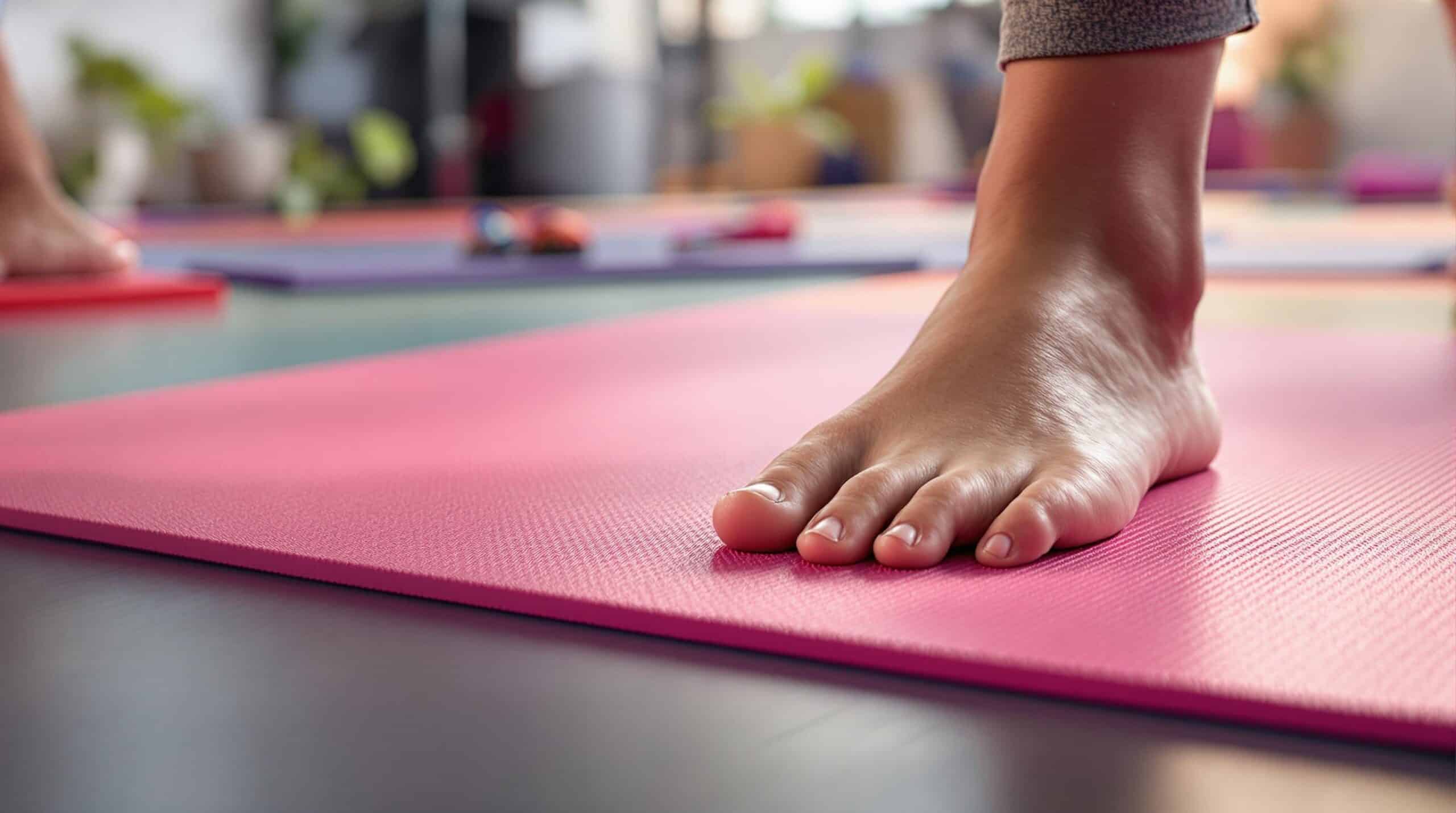 gym rubber flooring options
gym rubber flooring options
But with so many choices, how do you navigate this critical decision? Let’s break down the key factors to ensure you select the perfect rubber flooring for your specific needs.
Why is Rubber Flooring a Good Choice for Gyms?
Feeling like rubber flooring is just another trend, and unsure if it truly lives up to the hype? Don’t let doubts hold you back.
Rubber flooring1 provides excellent durability, sound absorption2, and safety, making it a popular choice for gyms. It can withstand heavy use, reduce noise levels, and provides a non-slip surface3 which minimize injuries.
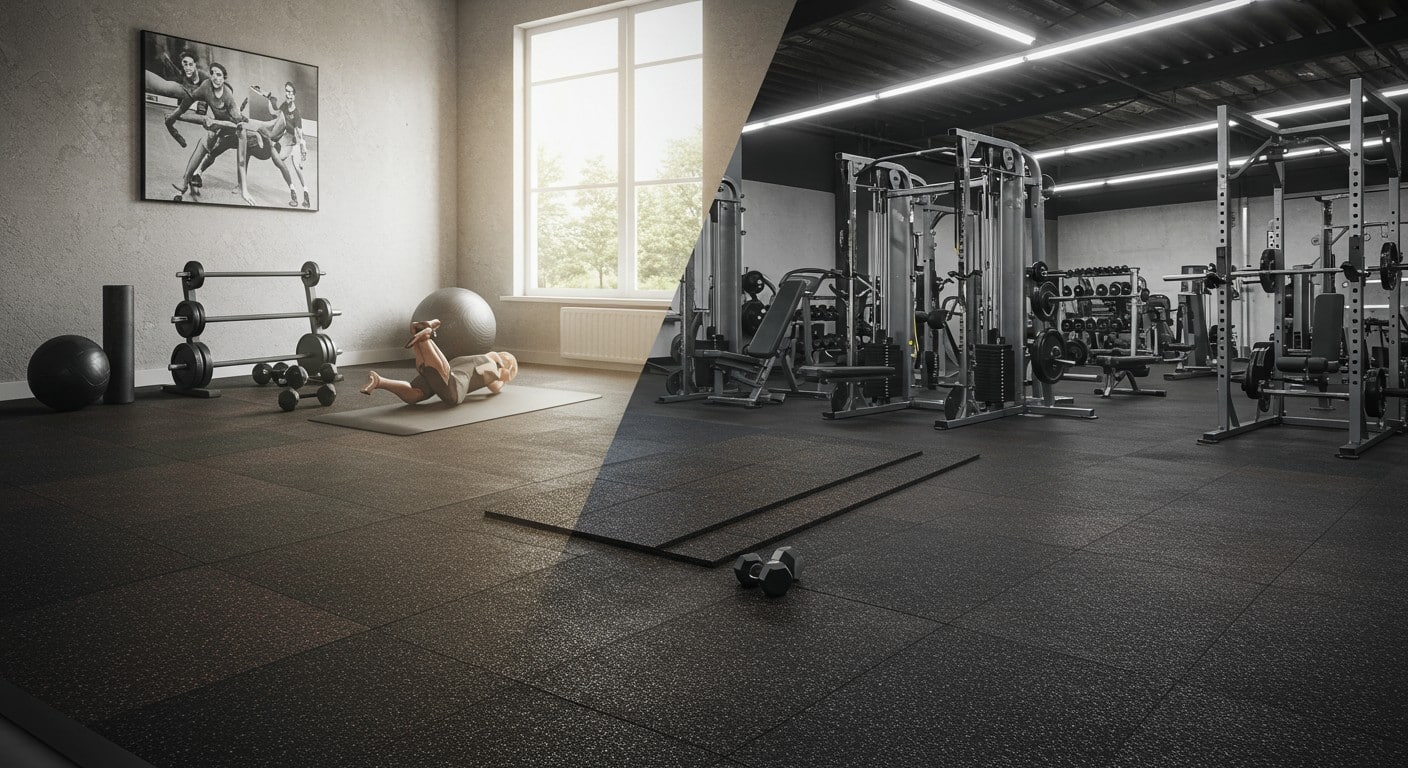 advantages of rubber flooring
advantages of rubber flooring
What are its advantages in durability?
Worried about your gym floor wearing out quickly under the constant stress of dropped weights and intense workouts? It’s a reasonable concern.
Rubber flooring is incredibly durable4. It is specially designed to withstand the impact of heavy equipment and high foot traffic, making it a long-lasting solution5 for your gym.
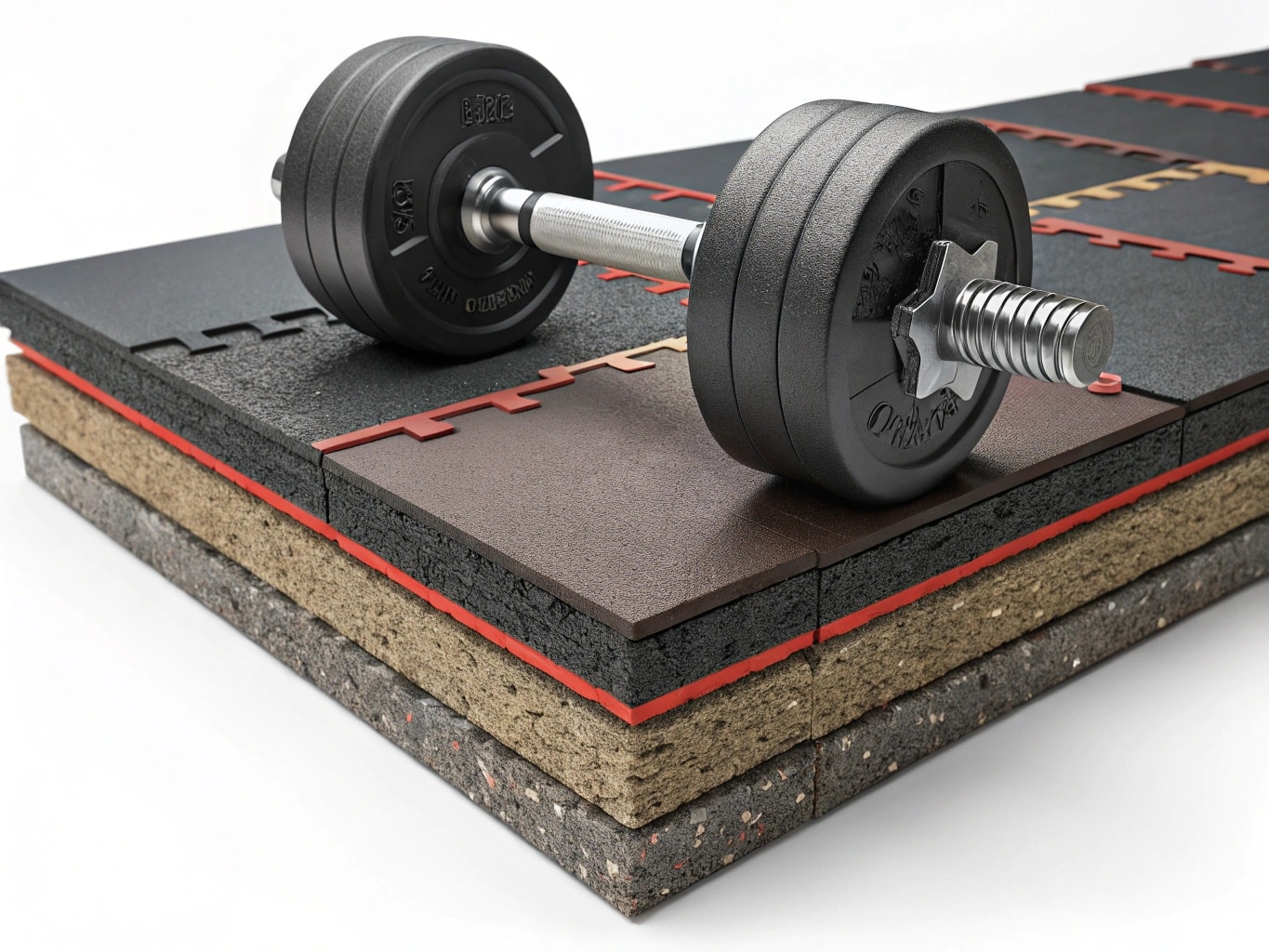 durability of rubber flooring
durability of rubber flooring
| Feature | Description | Benefit |
|---|---|---|
| Material | Typically made from recycled rubber tires or synthetic rubber (EPDM). | Environmentally friendly (recycled options), resilient, and resistant to wear and tear. |
| Impact Resistance | Designed to withstand heavy impacts from dropped weights, exercise equipment, and constant foot traffic. | Protects the subfloor, reduces noise, and extends the life of the flooring. |
| Longevity | With proper care, rubber flooring can last for many years, even in high-use areas. | Cost-effective in the long run due to its durability. |
| Fire Safety | Crucially, select rubber flooring with fire-resistant properties, especially for commercial gyms or areas near electrical equipment. Compliance with fire codes is a must! BYFIT offer fire-resistant options. | Minimizes fire risk, ensure your gym flooring safety. |
Is it good at absorbing sound?
Concerned about the noise levels in your gym disturbing neighbors or creating an unpleasant workout environment? It’s a common issue.
Rubber flooring effectively absorbs sound, minimizing the noise created by dropped weights and equipment. This is a huge benefit for both you and anyone nearby.
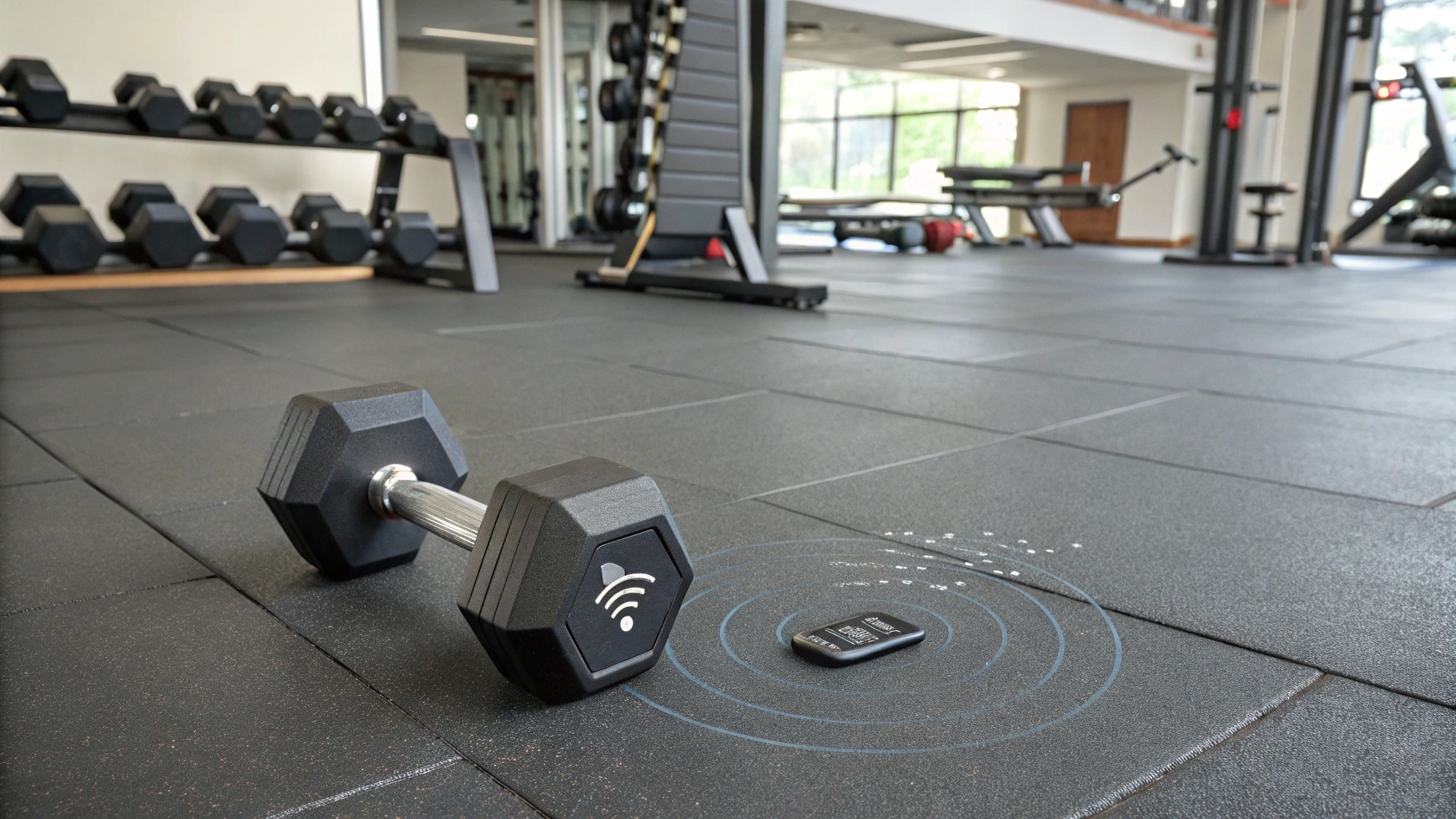 sound absorption of rubber flooring
sound absorption of rubber flooring
The density and thickness of rubber naturally dampen sound waves. Think of it like this: dropping a weight on concrete is like hitting a drum, while dropping it on rubber is like hitting a pillow. The rubber absorbs the impact and the sound.This creates a more comfortable and focused workout environment. It also can help to improve relationships with neighbors! And Don’t forget environmental considerations, choosing recycled rubber options6 can reduce your gym’s environmental impact.
What Types of Rubber Flooring Are Available?
Confused by the variety of rubber flooring options, and feel unsure which type best suits your gym’s needs? It is a common stumbling block.
There are three main types of rubber flooring: rolls, tiles, and mats. Each has its own advantages and is better suited for different applications.
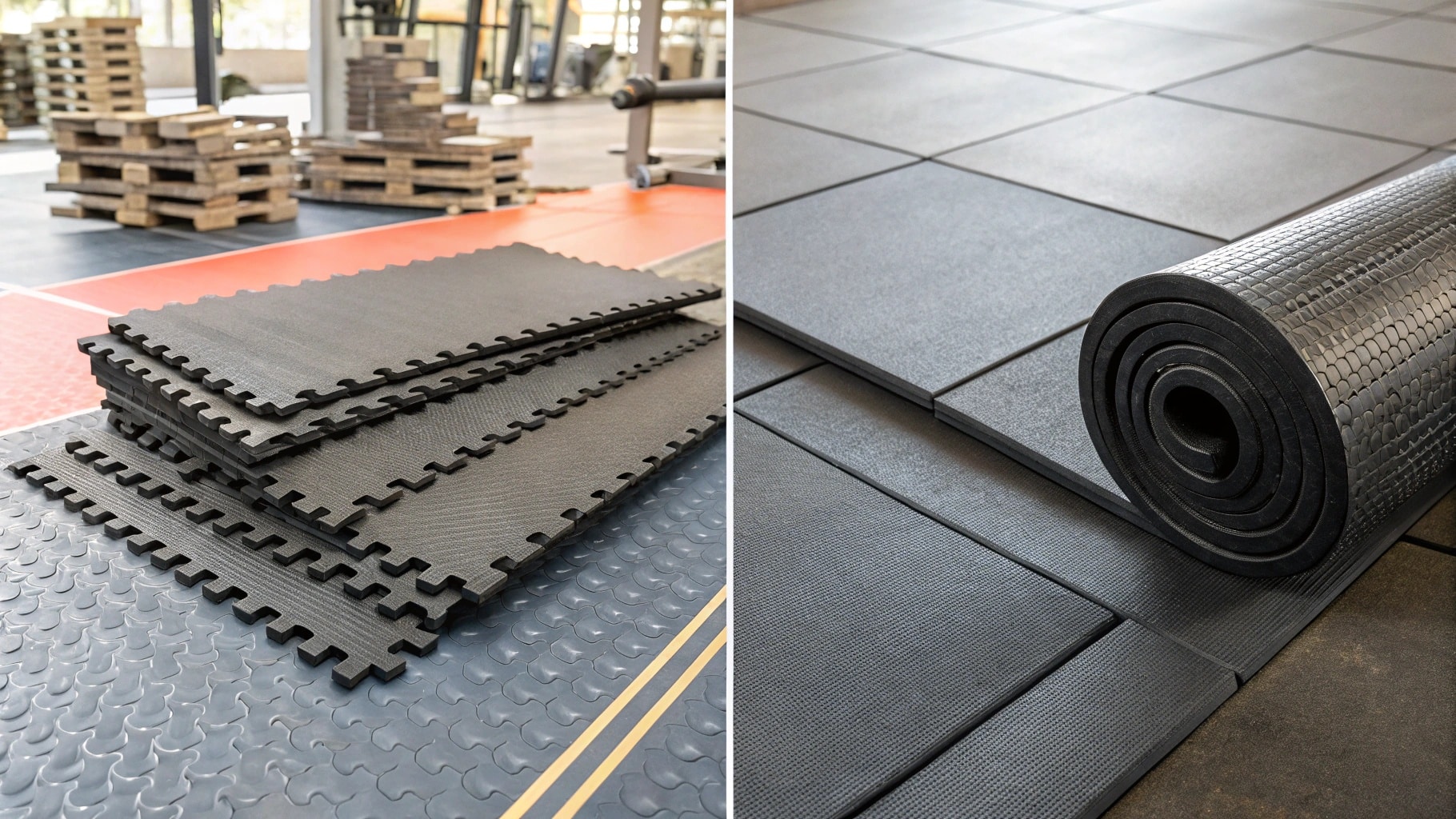 types of rubber flooring
types of rubber flooring
What Are the Key Differences Between Rolls, Tiles, and Mats?
Feeling unsure whether to choose rolls, tiles, or mats, and what makes each option unique? It’s a crucial decision.
Rolls7 provide seamless coverage for large areas. Tiles8 are easy to install and replace, and mats offer portability for specific workout zones.
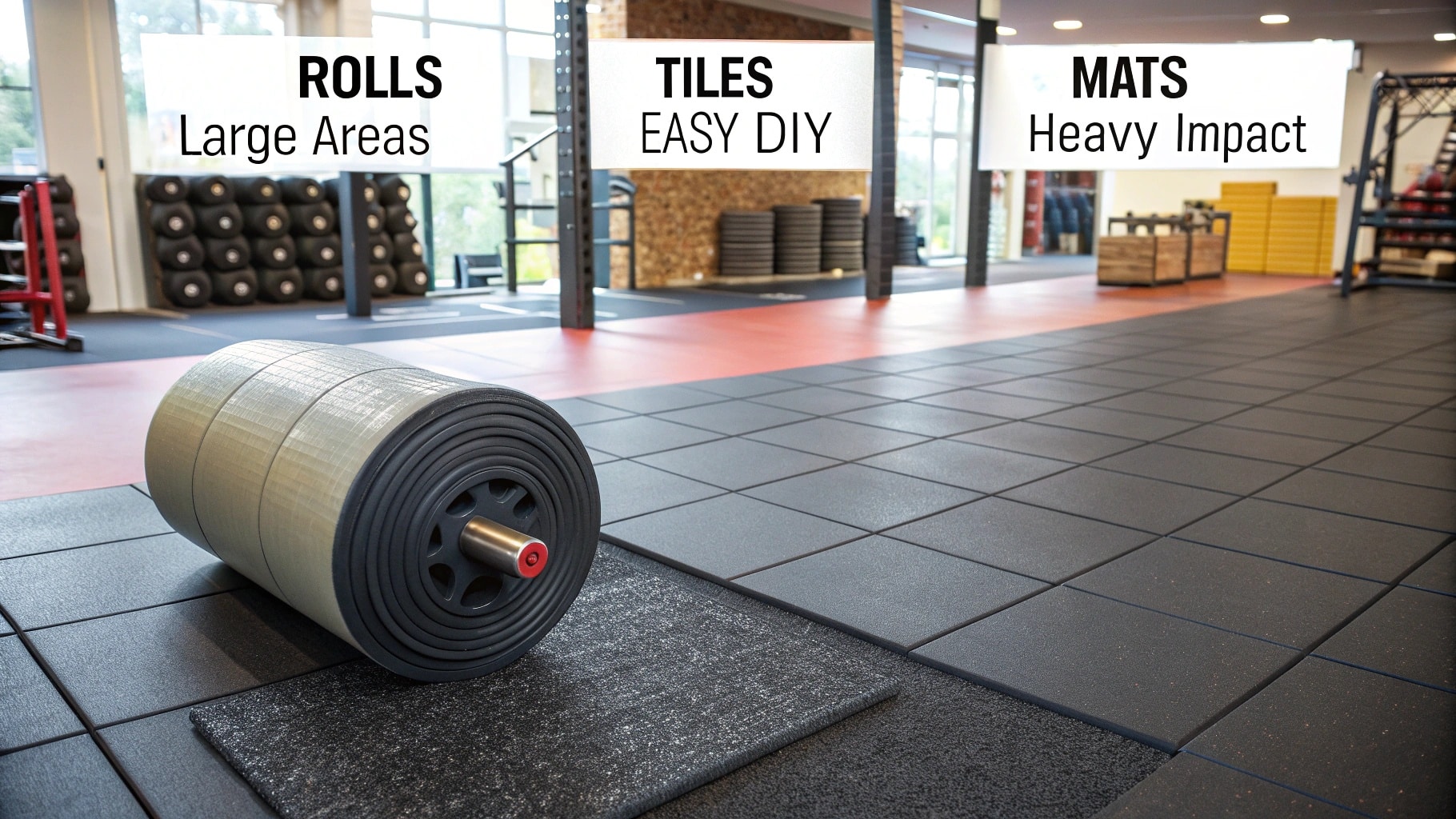 rolls vs tiles vs mats
rolls vs tiles vs mats
| Type | Description | Best For |
|---|---|---|
| Rolls | Large sheets of rubber, providing a seamless surface. | Large, open areas; covering entire gym floors. |
| Tiles | Interlocking squares or rectangles, easy to install and replace. | Smaller areas; creating custom designs; DIY installations. |
| Mats9 | Individual pieces, often thicker, designed for specific areas or exercises. | Weightlifting platforms; underneath heavy equipment; portable solutions. |
What Is Vulcanized Rubber, and Why Does It Matter?
Heard the term "vulcanized rubber10" but not sure what it means or why it’s important? You’re in the right place.
Vulcanized rubber is rubber that has been chemically treated to enhance its durability and elasticity11. This makes it more resistant to wear, temperature changes, and chemicals.
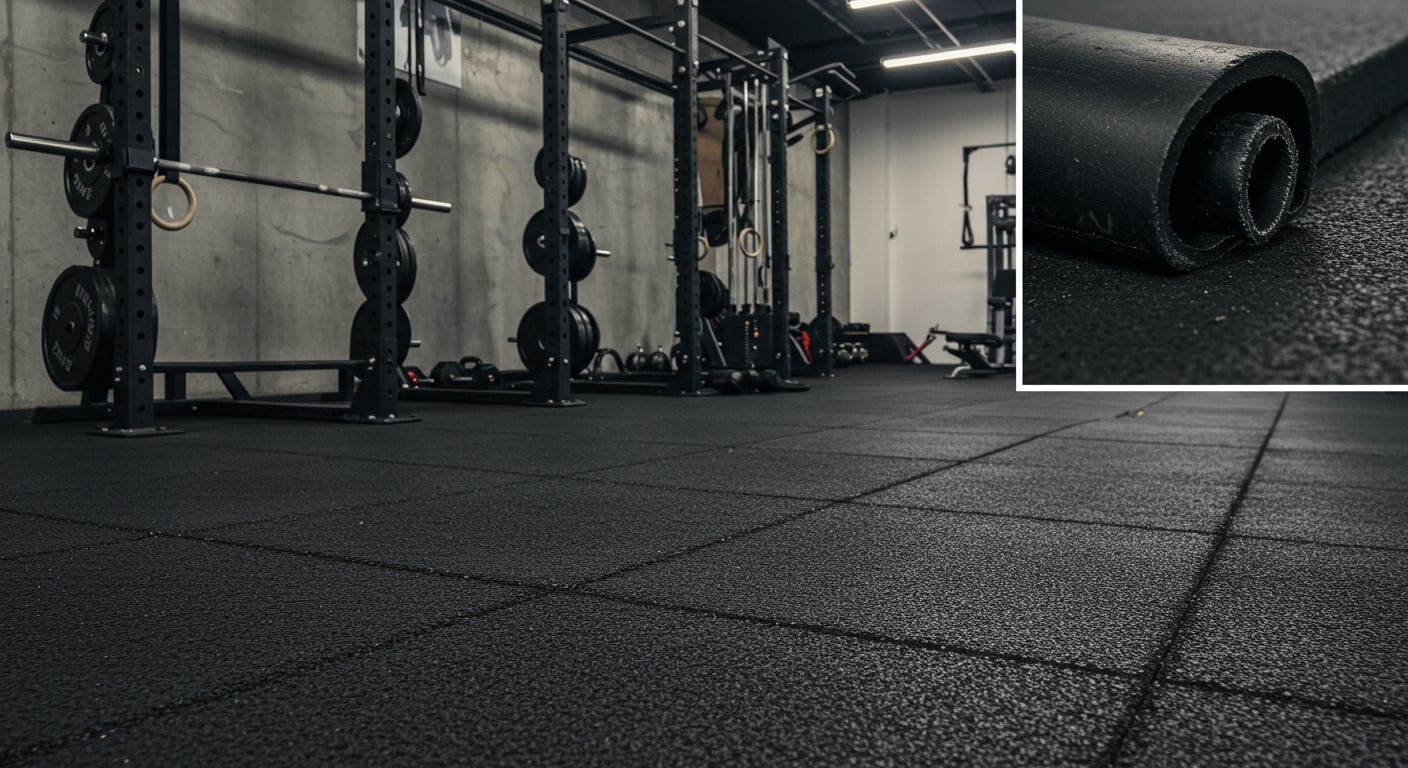 vulcanized rubber")]
vulcanized rubber")]
Think of it like baking a cake. The raw ingredients are mixed, then heat is applied to create a stronger, more stable final product. Vulcanization does the same for rubber. The chemical cross-linking12 in vulcanized rubber creates unmatched durability, making it 30% more resistant to heavy equipment impacts than non-vulcanized alternatives. This also ensures zero edge warping, even under massive weight, making it a great option for CrossFit zones. BYFIT can custom your gym rubber flooring.
How do I choose Rubber Flooring Thickness?
Feeling uncertain about selecting the right thickness for your rubber flooring, and fearing you’ll choose too thin or too thick? It’s a valid worry.
The appropriate thickness13 of rubber flooring depends on the type of activity and the weight being used. Thicker flooring is needed for areas with heavy weights14, while thinner options can be used for general training.
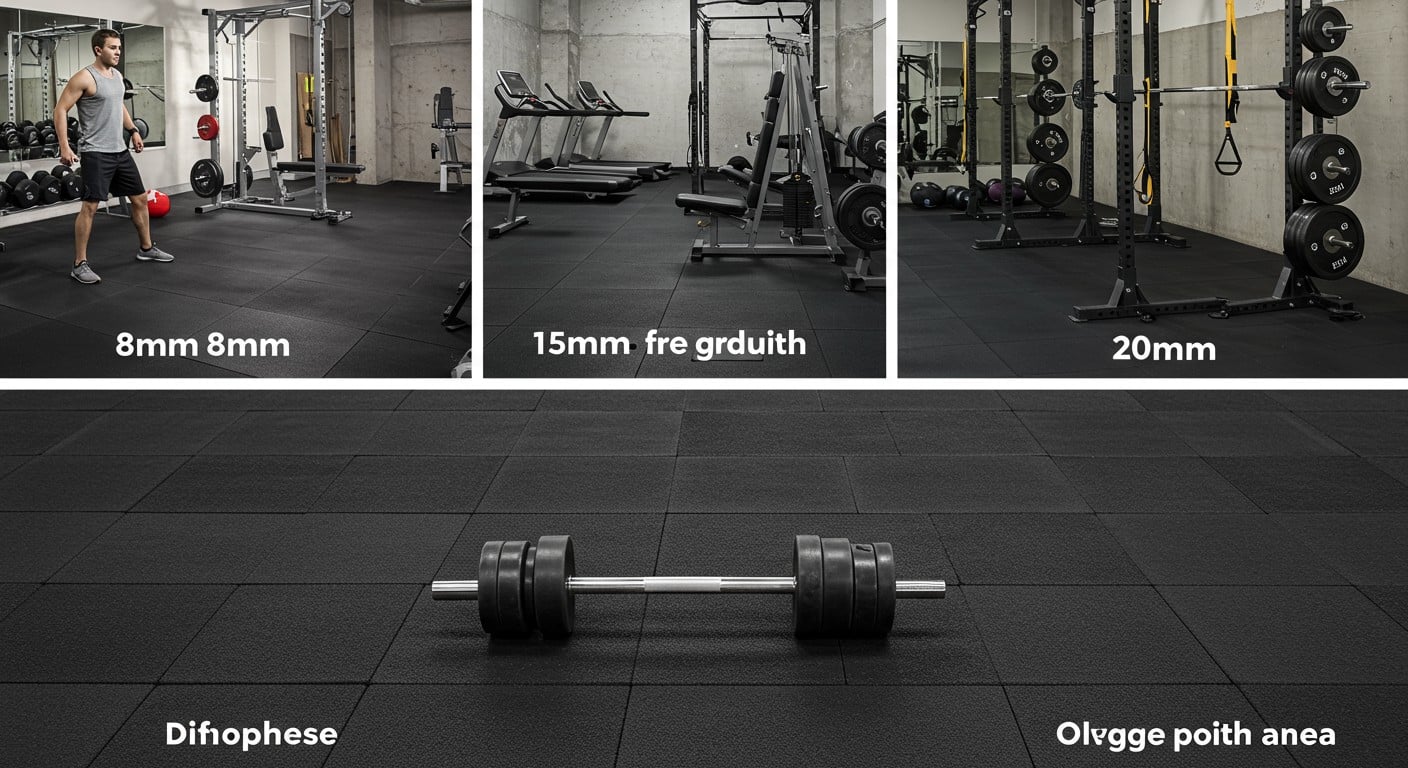 rubber flooring thickness
rubber flooring thickness
What thickness should I choose for heavy weight ares?
Concerned about damaging your subfloor or equipment with dropped weights in your heavy lifting area? It’s a real risk.
For heavy weight areas, such as those with Olympic lifting or powerlifting, choose thicker rubber flooring15, typically 20mm (about 3/4 inch) or more.
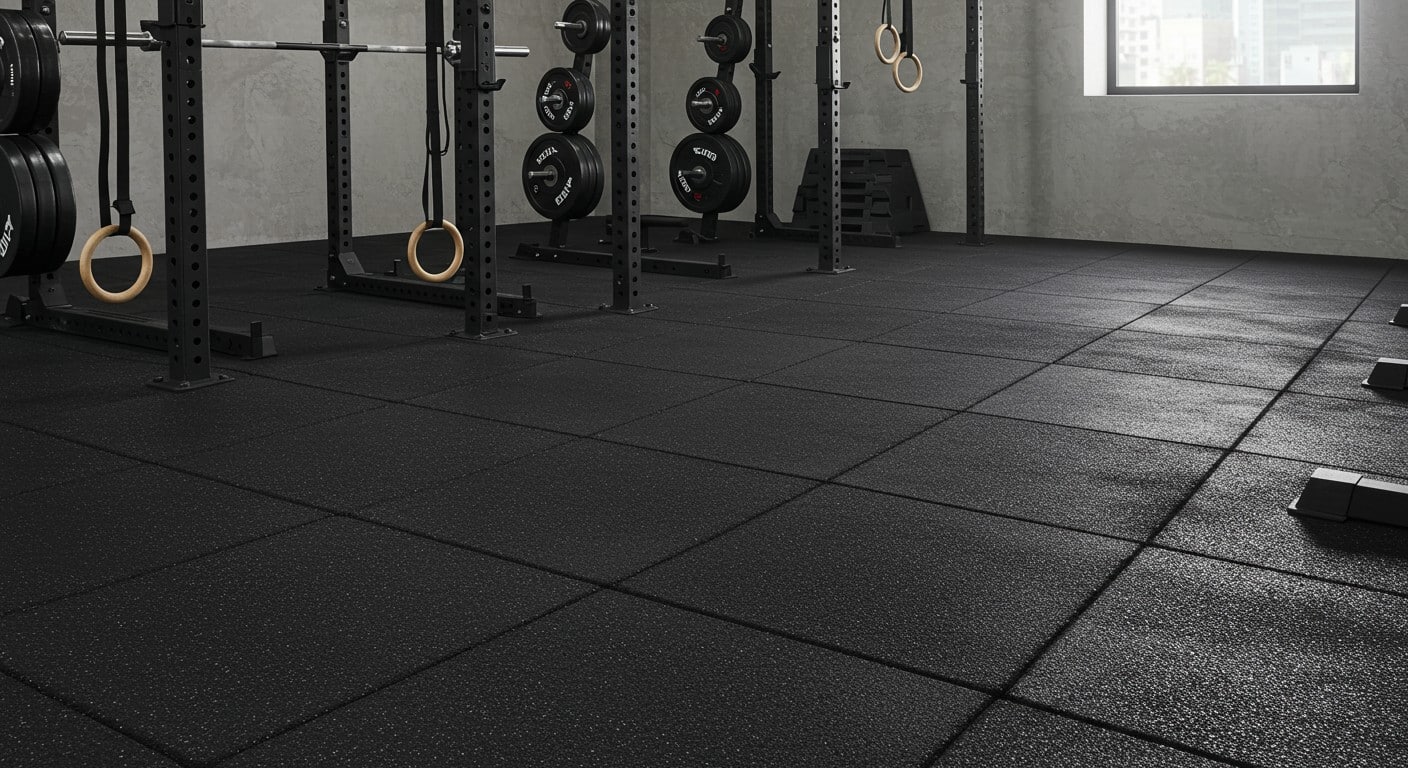 thick rubber flooring
thick rubber flooring
This provides maximum shock absorption16 and protection for both the subfloor and your equipment. But, thickness isn’t everything! High-density rubber cores (≥1.3g/cm³) can provide equivalent protection with thinner, more cost-effective options. BYFIT gym flooring are your best choice!
What thickness for normal training?
Unsure about the right thickness for general training areas, and fear overspending on unnecessarily thick flooring? It’s an important factor to keep in mind.
For general training areas, where lighter weights and bodyweight exercises are performed, 8mm (about 5/16 inch) to 10mm (about 3/8 inch) thick rubber flooring17 is usually sufficient.
 thinner rubber flooring
thinner rubber flooring
This offers enough cushioning and protection for most activities while being more cost-effective than thicker options. Remember to consider the vertical rebound rates18 (85%-90% is best) rather than just the thickness. This will tell you a lot more about the protective quality of the flooring.
How to maintain rubber flooring?
Regular maintenance will extend your rubber flooring’s lifespan. Here’s how to keep it in top condition:
 maintaining rubber flooring
maintaining rubber flooring
| Maintenance Task | Frequency | Description |
|---|---|---|
| Vacuuming | Daily/Weekly | Remove loose dirt, dust, and debris. Use a vacuum with a soft brush attachment to avoid scratching the surface. |
| Damp Mopping | Weekly/Bi-weekly | Use a damp mop with a pH-neutral cleaner19 specifically designed for rubber flooring. Avoid harsh chemicals or abrasive cleaners. |
| Deep Cleaning | Monthly/Quarterly | Use a more intensive cleaning solution and a soft-bristled brush20 to remove stubborn dirt and grime. Rinse thoroughly with clean water. |
| Stain Removal | As needed | Address spills and stains immediately. Use a rubber flooring cleaner and follow the manufacturer’s instructions. |
How to keep rubber flooring clean and tidy?
By implementing good hygiene practices and using modern flooring technology, you can significantly reduce cleaning efforts.
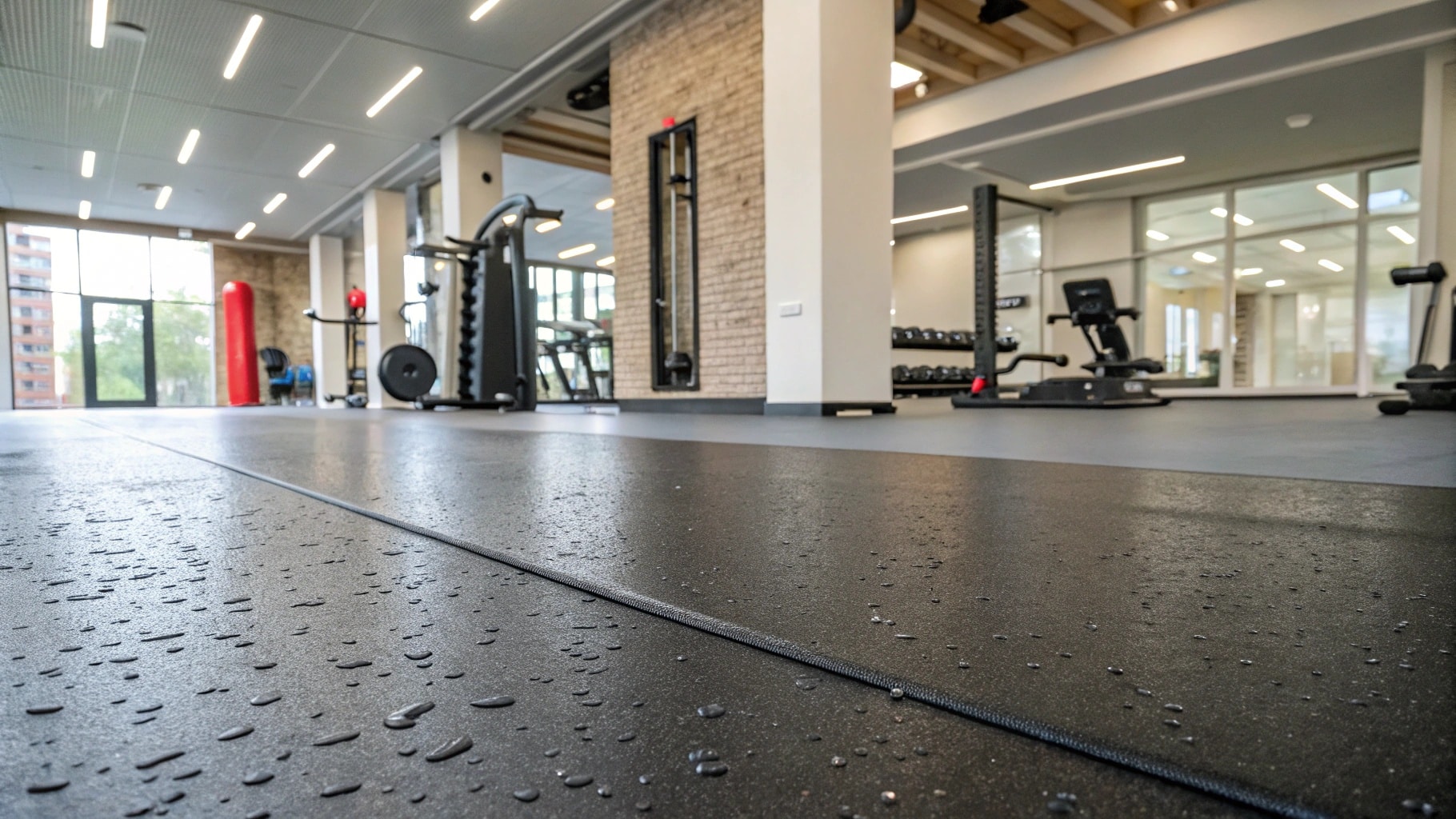 self cleaning rubber flooring
self cleaning rubber flooring
Modern rubber flooring often incorporates self-cleaning surface technology21. Micro-textured PVC-coated rubber flooring with hydrophobic nano-pores repels sweat and dust, greatly reducing cleaning frequency. Antimicrobial additives further enhance hygiene. Consider Subfloor Preparation: a clean, dry, and level subfloor is essential before installing. Fix any cracks or unevenness to ensure a perfect finish. Also, choose a color and pattern wisely. Darker colors hide stains, while lighter colors brighten the space. And consider the Long-Term Cost-Effectiveness22, investing in high-quality flooring might cost more initially, but it will save you money in the long run.
Conclusion
Choosing the right rubber flooring involves considering factors like durability, sound absorption, thickness, and maintenance. Balancing these elements ensures a safe, functional, and aesthetically pleasing gym space. Don’t hesitate to contact me ([email protected]) for further help – BYFIT is here to be your trusted partner!
-
Discover the numerous advantages of rubber flooring, including durability and safety, that make it ideal for gym environments. ↩
-
Learn how rubber flooring’s sound absorption properties can enhance your gym experience by reducing noise levels. ↩
-
Understand the critical role of non-slip surfaces in preventing injuries and ensuring safety during workouts. ↩
-
Learn how rubber flooring stands up against wear and tear compared to other materials, ensuring your gym investment lasts longer. ↩
-
Discover the features that contribute to the longevity of rubber flooring, ensuring your gym remains in top condition for years. ↩
-
Discover how recycled rubber options can reduce environmental impact while providing effective flooring solutions for gyms. ↩
-
Explore the advantages of rolls for seamless coverage in large areas, perfect for gym floors. ↩
-
Learn how tiles can simplify installation and customization for your workout space. ↩
-
Discover the versatility of mats for specific exercises and their portability for various workout zones. ↩
-
Understanding vulcanized rubber is crucial for its applications in various industries, enhancing durability and performance. Explore more to see its benefits! ↩
-
Durability and elasticity are essential for performance in many applications. Learn more about their importance in material selection and usage. ↩
-
Chemical cross-linking is a key process that enhances rubber’s properties. Discover how it works and its significance in material science. ↩
-
This resource will guide you in selecting the right thickness based on your specific needs, preventing costly mistakes. ↩
-
Learn about the best flooring options for heavy weights to ensure durability and safety in your workout space. ↩
-
Explore the advantages of thicker rubber flooring to protect your subfloor and equipment during heavy lifting. ↩
-
Understanding shock absorption can help you choose the right flooring to prevent damage and enhance safety in your gym. ↩
-
Understanding the ideal thickness for rubber flooring can help you make informed decisions and avoid overspending. ↩
-
Learning about vertical rebound rates can enhance your knowledge of flooring quality and performance, ensuring better choices. ↩
-
Learn about the significance of using pH-neutral cleaners to protect your rubber flooring from damage and wear. ↩
-
Find out why a soft-bristled brush is essential for effective cleaning without harming your rubber flooring. ↩
-
Explore this link to understand how self-cleaning technology can revolutionize your flooring maintenance and hygiene. ↩
-
Discover why investing in quality flooring can save you money over time and improve your space’s value. ↩

](https://www.byfitgear.com/wp-content/uploads/2025/02/Rubber-Floor-Tiles-Installation.jpeg)

